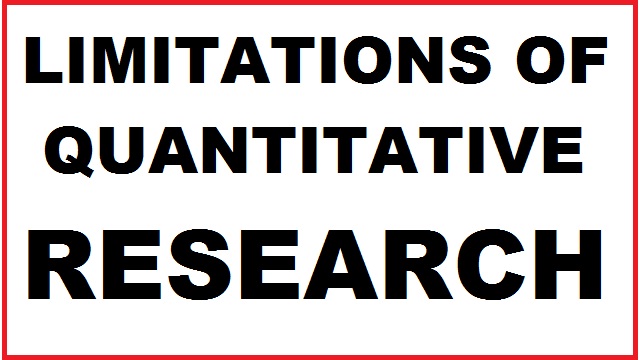LIMITATIONS OF QUANTITATIVE RESEARCH
LIMITATIONS OF QUANTITATIVE RESEARCH
RESEARCH: The word Research is composed of two syllables ,re and search .The dictionary defines the former as a prefix meaning again, a new or over again and the latter as a verb meaning to examine closely and carefully , to test and try ,or to probe .Together they form a noun describing a careful, systematic , patient study and investigation in some field of knowledge , undertaken to establish facts or principles .( Grinnel 1993:4)
So research is a structured inquiry that utilizes acceptable scientific methodology to solve problems and creates new knowledge that is generally applicable.
Qualitative Research: Qualitative Research involves collecting and analyzing non-numerical data (e.g., text, video, or audio ) to understand concepts,opinions, or experiences .It can be used to gather in-depth insights into a problem or generate new ideas for research .It is commonly used in the humanities and social sciences such as anthropology, sociology, education ,health sciences etc.
Example : How is anxiety experienced around the world .
QUANTITATIVE RESEARCH :
It is the process of collecting and analyzing numerical data. It can be used to find patterns and averages ,make predictions ,test causal relationships ,and generalize results to wider populations. This type of research is widely used in the natural and social sciences such as biology,psychology, economics, sociology, marketing etc.
Example: How has the average temperature changed globally over the last century?
LIMITATIONS OF QUANTITATIVE RESEARCH :
1.IMPROPER REPRESENTATION OF THE TARGET POPULATION :Improper representation of the target population might hinder the researcher for achieving its desired aims and objectives. Despite of applying appropriate sampling plan representation of the subjects is dependent of the probability distribution of the observed data .This may lead to miscalculation of probability distribution and lead to falsity in proposition.
2.LACK OF RESOURCES FOR DATA COLLECTION :Quantitative research methodology usually requires a large sample size .However due to lack of resources this large -scale research is impossible .
3.INABILITY TO CONTROL THE ENVIRONMENT :Sometimes researchers face problems to control the environment where the respondents provide answers to the questions in the survey (Baxter 2008). Responses often depend on particular time which again is dependent on the conditions during that particular time frame.
4.LIMITED OUTCOMES IN A QUANTITATIVE RESEARCH :Quantitative research method involves structured questionnaire with closed ended questions. It leads to limited outcomes outlined in the research proposal. So the results cannot always represent the actual occurring , in a generalized form.
5. EXPENSIVE AND TIME CONSUMING :Quantitative research is difficult, expensive and requires a lot of time to perform the analysis.
6.DIFFICULTY IN DATA ANALYSIS: Quantitative study requires extensive statistical analysis , which can be difficult to perform for researchers from non-statistical backgrounds. Quantitative research is a lot more complex for social sciences ,education .Effective response should depend on the research problem rather than just a simple yes or no response.
7.Advance formulation of specific hypotheses is an important requirement of quantitative research .In certain research contexts, especially in the field of education ,it is not always possible to formulate specific hypothetical generalizations.
8.The occurrence of an event is both quantitative and qualitative .Hence its measurement on the basis of selective observation and selective recording of information may involve researcher “bias”.
9.NEGLECTING CONTEXTUAL VARIABLES :Both the physical settings e.g. schedules,space,pay and internalized notions of norms, traditions ,roles and values are crucial contextual variables. Research must be conducted in the setting where all the contextual variables are operating .




Comments
Post a Comment